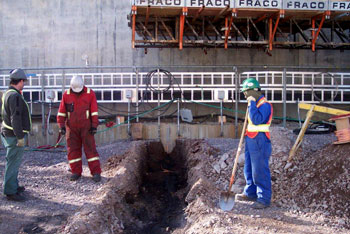
MYTH
Lightning will never strike the same spot twice.
TRUTH
A good example is the CN Tower, which is struck an average of 100 times per year.
Lightning will never strike the same spot twice.
TRUTH
A good example is the CN Tower, which is struck an average of 100 times per year.
- How does a lightning protection system work?Lightning Protection Systems consist of three major parts; Lightning Rods, Conductors and Grounding. The lightning rods are positioned on locations where lightning is most likely to strike such as a roof peaks, dormers, chimneys, cupolas etc. The conductor (cable) interconnects the lightning rods and provides a safe path to ground for the lightning. The grounding system dissipates the lightning safely into the ground. A properly installed lightning protection system intercepts a lightning strike and provides a safe route for lightning to travel around a structure and down to ground, in lieu of penetrating the structure and causing damage.
- Does a lightning protection system attract lightning?No, a lightning protection does not attract, nor deter lightning. In the event that lightning recognizes a structure as its target, the lightning protection system acts as a canopy of protection, intercepting the lightning and providing a safe path to ground.
- What does a lightning protection system cost?The architectural make-up of a structure roof elevations, chimneys, dormers, roof equipment, etc. determines the cost of the lightning protection system. Each structure has its own specific lightning protection design and installation. This design and installation must meet CSA B72 Code Requirements for Lightning Protection Systems. Lightning protection is a great investment and an inexpensive component of the overall security package available today. It offers peace of mind and proven protection for your family, structure, business, and valuables. Island Lightning Rod provides free estimates upon request.
- Can I install my own lightning protection system?No, an improperly installed system is very dangerous. Lightning protection is a specialized industry requiring trained installers. A properly designed and installed system conforms to code requirements along with provincial government regulations and standards in the jurisdiction. The system must be installed to the structure’s design, construction, electrical composition, soil conditions, location and more.
- What will the lightning protection system look like?Most commonly, lightning protection is inconspicuous and virtually undetectable. Island Lightning Rod Co. Ltd uses the structural elements and design features to hide the components of the lightning protection system. In addition, the materials chosen are the best for the aesthetics for your home. For example, since copper wears to a dark finish, it is not practical to install that material on a white stone home. Instead, our installers would use aluminum or tin coated copper, which weathers to a dull silver to compliment the white stone. Installing a system on new construction, the customer has the option of going with a concealed system where the system is installed on the interior framework of the structure.
- Does a lightning protection system require regular maintenance?No maintenance is required unless your structure or roof changes. These changes may include, but are not limited to, additions, roof renovations, satellite dish installations, etc. Lightning protection systems are constructed of durable materials that are likely to outlast most other fixtures on your structure.
- My structure is not located in a high area. Can I still get hit by lightning?Yes, lightning strikes in low areas as well as in higher elevations. Lightning is very unpredictable and does not discriminate as to what or where it strikes.
- If my structure is grounded do I still require lightning protection?Yes, electrical grounding is to assure electrical safety and does not prevent lightning damage. It is only one component of an entire lightning protection system.
- Why Should I install lightning protection if I have insurance?
- Insurance does not prevent lightning from striking; it comes into play after the damage is done.
- Insurance does not protect you and your family from electrocution or fire due to lightning.
- Insurance does not prevent the hassles, hidden expenses of a major insurance claim.
- Insurance does not protect against the loss of items with sentimental value or historic records.

There are two types of lightning protection systems:
Copper and Aluminum
A copper lightning protection system uses all copper materials to complete the job
An aluminum lightning protection system uses all aluminum materials above grade level to complete the job.
Many people are unaware, but aluminum systems are fully approved and meet code requirements. With the increases in copper costs, aluminum systems are becoming more popular as a cost efficient system.
Copper and Aluminum
A copper lightning protection system uses all copper materials to complete the job
An aluminum lightning protection system uses all aluminum materials above grade level to complete the job.
Many people are unaware, but aluminum systems are fully approved and meet code requirements. With the increases in copper costs, aluminum systems are becoming more popular as a cost efficient system.
